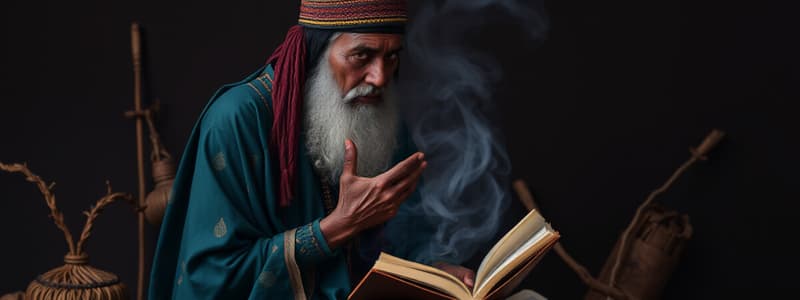Podcast
Questions and Answers
What term describes art that is produced by indigenous peoples?
What term describes art that is produced by indigenous peoples?
- Cultural art
- Indigenous art (correct)
- Traditional art
- Contemporary art
Which of the following best describes organic shapes in art?
Which of the following best describes organic shapes in art?
- Shapes that originate from nature (correct)
- Geometric shapes defined by lines
- Shapes derived from human-made objects
- Shapes created by abstract expressions
What element of art is described as the illusion of depth on a flat surface?
What element of art is described as the illusion of depth on a flat surface?
- Space (correct)
- Line
- Form
- Texture
Which literary form is characterized by a narrative divided into chapters?
Which literary form is characterized by a narrative divided into chapters?
What is the primary purpose of a 'pabula' in literature?
What is the primary purpose of a 'pabula' in literature?
What term refers to the building blocks that define various forms of art?
What term refers to the building blocks that define various forms of art?
Which of the following best describes a 'tula' in Filipino literature?
Which of the following best describes a 'tula' in Filipino literature?
What characterizes 'negative space' in a visual composition?
What characterizes 'negative space' in a visual composition?
Which of the following ethnic groups is known to have arrived during the Paleolithic age?
Which of the following ethnic groups is known to have arrived during the Paleolithic age?
What is the function of 'talumpati' in Filipino culture?
What is the function of 'talumpati' in Filipino culture?
Study Notes
Art and Creativity
- Art represents the application of human creative skills across various forms and mediums.
- Indigenous art is specifically created by indigenous peoples, reflecting unique cultural expressions.
Azarias and Indigenous Literature
- Azarias highlights literature as an expression of human feelings and emotions.
- Indigenous literature serves as a vehicle for cultural storytelling, preserving traditions and experiences.
Key Concepts in Indigenous Culture
- Indigenous identity is deeply tied to place-based ethnic culture, emphasizing connection to land and heritage.
- Webster defines literature as a manifestation of the human mind and feelings.
Elements and Fundamentals of Art
- Elements of art are essential building blocks, including line, shape, space, form, color, and texture.
- Lines create marks on surfaces, while shapes are enclosed two-dimensional forms, whether organic or geometric.
Space and Composition
- Space refers to the illusion of depth on a flat surface; negative space is the area surrounding an object, while positive space is the area occupied by it.
- Form includes the shape and volume of a work.
Color and Texture
- Color in art is produced by light, while texture refers to the perceived surface quality of an artwork, influencing the viewer's experience.
- Shade and tint adjust color values, adding depth and dimension to artistic pieces.
Indigenous Historical Context
- The Tabon Man is noted as the oldest human fossil found in the Philippines, linking to early human history.
- Negritos are believed to have arrived during the Paleolithic era, contributing to the indigenous population.
Migration and Cultural Exchange
- Indonesians are recognized as the first sea immigrants to the Philippines, influencing cultural and social dynamics.
- Mongoloid refers to a racial group with affinities to Caucasians, reflecting the diverse genealogical background of the region.
Literature Forms
- Different forms of indigenous literature include:
- Nobela: long narratives divided into chapters.
- Maikling kwento: short stories featuring a central character.
- Dula: plays performed on stage, structured in acts.
- Alamat: tales rooted in truth, often conveying moral lessons.
- Pabula: fables aiming to awaken children's minds.
- Anekdota: fictional narratives crafted by the writer.
Key Figures in Filipino Literature
- Julian Cruz Balmaceda and Inigo Regalado are notable for their depictions of beauty in literature.
- Fernando Monleon is recognized for his artistic mimicry and contributions to performance arts.
- Alejandro Abadilla emphasizes the awakening of consciousness and cultural awareness.
Musical Traditions
- Music plays a vital role in Filipino culture, serving as an integral part of nearly all occasions, from festivals to ceremonies.
- Chordophones encompass ethnic dances and songs, such as the Tangkol, highlighting the importance of rhythm and movement in cultural expression.
Indigenous Festivals
- Ati-Atihan is a celebrated festival of the Malay people, showcasing cultural unity and artistic expression through dance and music.
Types of Poems
- Tula is a traditional form of poetry, often teaching morals and wisdom, with a single core idea driving the narrative.
- Tulang Pasalaysay captures significant life events, documenting human experiences through poetic storytelling.
Studying That Suits You
Use AI to generate personalized quizzes and flashcards to suit your learning preferences.
Description
Explore the various applications of human creative skills through literature and indigenous culture. This quiz delves into the expression of emotions and the significance of place-based human experiences. Test your knowledge on the intertwining of creativity and cultural identity.



